Home / Ethers From Alkenes, Tertiary Alkyl Halides and Alkoxymercuration
Alcohols, Epoxides and Ethers
Ethers From Alkenes, Tertiary Alkyl Halides and Alkoxymercuration
Last updated: September 15th, 2023 |
When The Williamson Doesn’t Work: Synthesis of Tertiary Ethers From Alkenes, SN1 Reactions, and Alkoxymercuration
In the last two posts we’ve been discussing the Williamson synthesis of ethers. As we saw, our discussion was essentially a complete re-hash of everything we’d already said about the SN2 reaction that was covered awhile back.
That’s the fun* thing about organic chemistry – things you learn in the early stages of the course often come back in different forms later in the course. (*your definition of “fun” may vary)
Today’s post is similar in that we’re just going to be going back to old reactions we’ve already seen and look at them in a new light.
In this post, we’ll cover making ethers via SN1 reactions and also through oxymercuration.
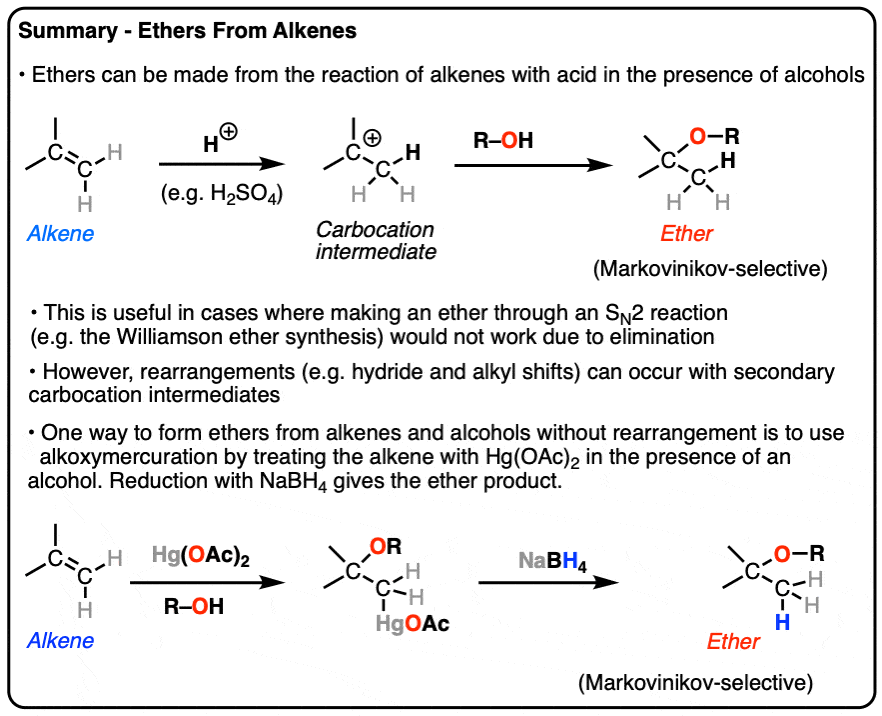
Table of Contents
- How To Make Ethers of Tertiary Alcohols When The Williamson (SN2) Isn’t An Option?
- Synthesis of Ethers via SN1 Reactions
- Three Examples of Ether Formation Involving Addition of a Tertiary Alcohol To A Carbocation
- Avoiding Carbocation Rearrangements With Alkoxymercuration
- Summary: Synthesis of Ethers via SN1 (and related) Reactions
- (Advanced) References and Further Reading
1. How To Make Ethers of Tertiary Alcohols When The Williamson (SN2) Isn’t An Option?
We ended the last post by posing a question. How do we synthesize ethers like this one below (di-t-butyl ether) ?
We saw that when we attempt to form ethers like this through a Williamson reaction, it fails miserably – giving us elimination products (via an E2) rather than the desired ether. (See article: Williamson Ether Synthesis)
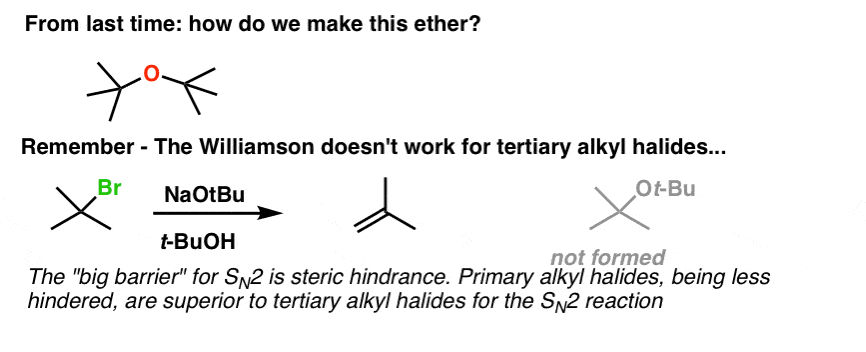
Let’s think about this for a second. Back when we covered substitution reactions, we learned that the SN2 was best for primary alkyl halides and poorest for tertiary alkyl halides, due to steric hindrance. (See post: The SN1 Mechanism)
But there was a different substitution reaction we learned that was actually superior for tertiary alkyl halides versus primary alkyl halides – the SN1 – and it had to do with the greater stability of tertiary carbocations versus secondary versus primary carbocations. (See post: The SN1 Mechanism)
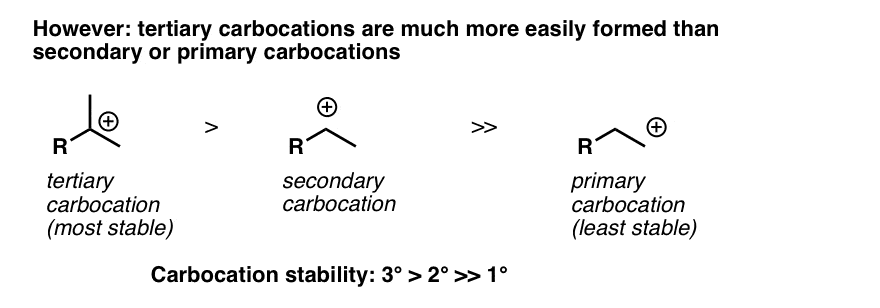
2. Synthesis of Ethers via Reactions of Alcohols With Alkenes or Alkyl Halides
In fact, we encountered carbocations not only in SN1 reactions but in another type of reaction as well. If we take an alkene and add acid, recall that we end up forming a new C-H bond on the least substituted carbon of the alkene and we form a carbocation on the more substituted carbon of the alkene (remember Markovnikov’s rule?). (See article: Markovnikov’s Rule)
This might get you to thinking – can we use either of these reactions to form ethers, via a carbocation intermediate?
Sure!
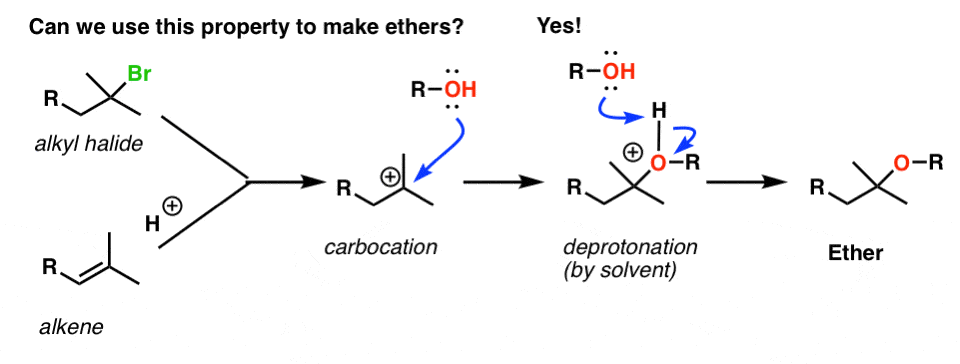
We can form this carbocation two ways.
If we dissolve an alkyl halide in the appropriate alcohol solvent, eventually the leaving group will leave, forming the carbocation – which is then trapped by the alcohol solvent. After removal of a proton, we’re left with our ether. This is a classic SN1 reaction.
Alternatively, if we start with an alkene in an appropriate alcohol solvent, and treat with a strong acid – ideally a strong acid with a poorly nucleophilic counter ion [ yes to H2SO4 and TsOH as acids, generally no to HCl, HBr, and HI] the carbocation will likewise be generated, which is then trapped via the same pathway as before.
3. Three Examples Of Ether Formation Involving Addition Of an Alcohol To A Tertiary Carbocation
Let’s look at three examples. The first one is a typical SN1 reaction. The second one is an alkene addition reaction. The third one is alkene addition… with a twist!
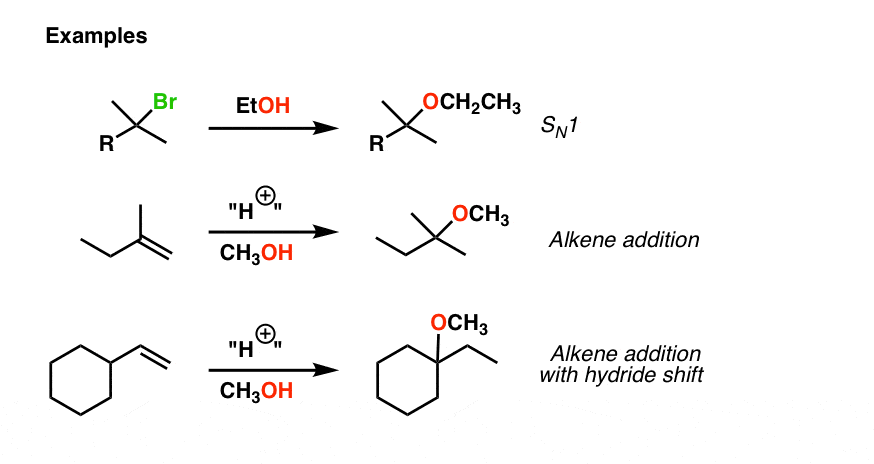
[Note – I didn’t put the mechanisms of these reactions in because we’ve talked about these mechanisms so many times before. To see them, hover here or click this link.
click here to see the mechanism of these three reactions]
4. Avoiding Carbocation Rearrangements By Using Alkoxymercuration
“Oh yes”, you might be saying at this point, like someone who suddenly finds themselves awkwardly face-to-face with an old ex-boyfriend or ex-girlfriend. “Rearrangements.” Yes, rearrangements again!
Anytime we deal with carbocation intermediates, rearrangements are going to be something to watch out for. If we form, for example, a secondary carbocation adjacent to a tertiary or quaternary carbon, expect a hydride or alkyl shift (respectively) that will result in a more stable carbocation.
There is, however, a way out!
In particular, there’s a way we can form ethers from alkenes in a way that doesn’t involve a carbocation intermediate. It’s also a reaction we’ve seen before: oxymercuration. (See post: The Three-Membered Ring Pathway)
Oxymercuration involves dissolving the starting alkene in an alcohol solvent and adding a source of mercury(II) like Hg(OAc)2 . A “mercurinium” ion is formed, which is then attacked at the most substituted position by one of the molecules of alcohol solvent.
After removal of a proton, we’re left with the product of “oxymercuration”. The mercury can then be removed by treatment with sodium borohydride (NaBH4). We often don’t cover the mechanism, but if you’re curious, hover here or click this link.
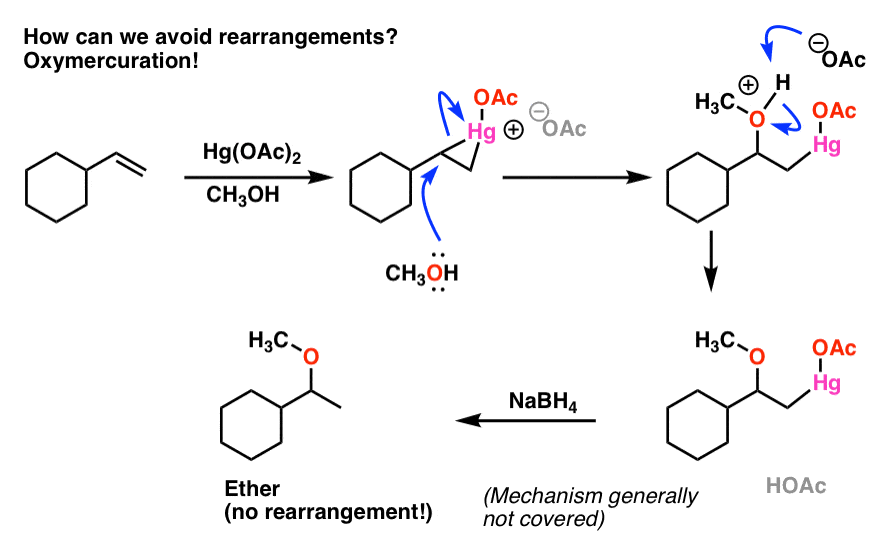
Note that we’ve succeeded in adding “CH3OH” in this example across the alkene without any rearrangement occurring.
5. Summary: Synthesis of Ethers Through SN1 (And Related) Reactions
To summarize, we’ve revisited three methods today for ether synthesis:
- Ether synthesis via SN1 reaction of tertiary alkyl halides
- Ether synthesis via acid catalyzed addition of alcohols to alkenes
- Oxymercuration of alkenes in alcohol solvent
These serve as a useful alternative to the Williamson in cases where we want to build ethers of secondary and tertiary alcohols.
Now that you’ve covered the basics of ether synthesis, the world is your oyster. Just wait until you learn about all the exciting things we can do with ethers now that we know how to make them.
The next post in this series is going to be so exciting, I’m having a very difficult time restraining myself from spilling the beans. Yet, I must.
Excitement awaits!
Next Post – Ether Synthesis Via Alcohols And Acid
Notes
Related Articles
- Alcohols To Ethers via Acid Catalysis
- The SN2 Mechanism
- Comparing the E1 vs SN1 Reactions
- Alkene Addition Pattern #2: The “Three-Membered Ring” Pathway
- Markovnikov Addition Of HCl To Alkenes
- Oxymercuration of Alkenes to form Ethers using Hg(OAc)2
- Oxymercuration Demercuration of Alkenes
- Acid-Catalyzed Addition of H2O To Alkenes
(Advanced) References and Further Reading
- Solvomercuration-demercuration of representative olefins in the presence of alcohols. Convenient procedures for the synthesis of ethers
Herbert Charles Brown and Min-Hon Rei
Journal of the American Chemical Society 1969, 91 (20), 5646-5647
DOI: 1021/ja01048a042
Original paper by Prof. H. C. Brown on ‘solvomercuration’-demercuration to synthesize ethers by Markovnikov addition of the alcohol, without rearrangement. What is noteworthy in reading this paper is that the reaction is fast – the mercuration takes about 10 minutes, after which the basic NaBH4 solution is added. It takes about 2 hours for demercuration to complete. -
DL-Serine
Herbert E. Carter and Harold D. West.
Org. Synth. 1940, 20, 81DOI: 10.15227/orgsyn.020.0081
The first step of this process is an alkoxymercuration reaction of methyl acrylate with Hg(OAc)2 in methanol. (Interestingly, it goes anti-Markovnikov due to the electron-withdrawing effect of the adjacent methyl ester). The mercury is then replaced with bromine (via Br2) and the resulting alkyl halide then undergoes SN2 with NH3, giving the amino acid. - Activation of olefins via asymmetric Brønsted acid catalysis
Nobuya Tsuji, Jennifer L. Kennemur, Thomas Buyck, Sunggi Lee, Sébastien Prévost, Philip S. J. Kaib, Dmytro Bykov, Christophe Farès, Benjamin List
Science 2018: Vol. 359, Issue 6383, pp. 1501-1505
DOI: 10.1126/science.aaq0445
Prof. Benjamin List (now at Max Planck Institute, Germany) is a key contributor to the field of organocatalysis. In this paper, he describes the use of a bulky chiral Brønsted acid for asymmetric, intramolecular ether synthesis. By using this acid, one face of the intermediate cation that is formed from protonation of the olefin will be blocked, thus favoring a selective addition. - Catalysts for forming Diethyl Ether
Inventors: Cheng Zhang, Victor J. Johnson
Assignee: Celanese International Corp.
Publication Date: 18, 2014
Pub. No.: US 20140275636A1
This describes an industrial process for diethyl ether synthesis, which is done using a heterogeneous catalyst. - Single stage synthesis of diisopropyl ether – an alternative octane enhancer for lead-free petrol
Frank P. Heese, Mark E. Dry, Klaus P. Möller
Catalysis Today 1999, 49 (1-3), 327-335
DOI: 1016/S0920-5861(98)00440-4
This paper shows that the mechanism for formation of symmetrical ethers from secondary alcohols (e.g. isopropanol) is more complex, as bimolecular dehydration can compete with other pathways (e.g. SN1 or elimination-addition). Diisopropyl ether is sometimes used as a solvent but requires even more care with handling and storage compared to other ethers, as it is even more prone to formation of explosive peroxides. - Process for Preparing Diisopropyl Ether
Inventor: Hanbury John Woods
Assignee: Gulf Oil Canada Limited
Publication Date: 16, 1977
Pub. No.: US 4,042,633
A patent on an industrial process for preparing diisopropyl ether from isopropanol. This is also done with a heterogeneous catalyst (Montmorillonite clay in this case). - Reactions of phenols and alcohols over thoria: Mechanism of ether formation
Karuppannasamy, K. Narayanan, C. N. Pillai
J. Catalysis 1980, 66 (2), 281-289
DOI: 10.1016/0021-9517(80)90032-9
Under forcing conditions, phenol can dehydrate to diphenyl ether, but this proceeds through an unusual mechanism. - Stable carbocations. Part 275. The dodecahedryl cation and 1,16-dodecahedryl dication. Proton and carbon-13 NMR spectroscopic studies and theoretical investigations
George A. Olah, G. K. Surya Prakash, Wolf Dieter Fessner, Tomoshige Kobayashi, and Leo A. Paquette
Journal of the American Chemical Society 1988, 110 (26), 8599-8605
DOI: 1021/ja00234a004 - Stable carbocations. Part 267. Pagodane dication, a unique 2.pi.-aromatic cyclobutanoid system
K. Prakash, V. V. Krishnamurthy, Rainer Herges, Robert Bau, Hanna Yuan, George A. Olah, Wolf Dieter Fessner, and Horst Prinzbach
Journal of the American Chemical Society 1986, 108 (4), 836-838
DOI: 10.1021/ja00264a046
One of the big challenges in synthetic organic chemistry in the late 20th century was the synthesis of the Platonic hydrocarbon dodecahedrane (C20H20). Many groups all over the world attacked this problem from many angles, and the eventual ‘winner’ was Prof. Leo Paquette (Ohio State University). Prof. Horst Prinzbach (U. Freiburg, Germany) approached this by attempting to isomerize the hydrocarbon ‘pagodane’ (so called because of the shape). Both dodecahedrane and pagodane give solutions of stable carbocations in superacidic media, and quenching these solutions in cold methanol yields the methyl esters.
00 General Chemistry Review
01 Bonding, Structure, and Resonance
- How Do We Know Methane (CH4) Is Tetrahedral?
- Hybrid Orbitals and Hybridization
- How To Determine Hybridization: A Shortcut
- Orbital Hybridization And Bond Strengths
- Sigma bonds come in six varieties: Pi bonds come in one
- A Key Skill: How to Calculate Formal Charge
- The Four Intermolecular Forces and How They Affect Boiling Points
- 3 Trends That Affect Boiling Points
- How To Use Electronegativity To Determine Electron Density (and why NOT to trust formal charge)
- Introduction to Resonance
- How To Use Curved Arrows To Interchange Resonance Forms
- Evaluating Resonance Forms (1) - The Rule of Least Charges
- How To Find The Best Resonance Structure By Applying Electronegativity
- Evaluating Resonance Structures With Negative Charges
- Evaluating Resonance Structures With Positive Charge
- Exploring Resonance: Pi-Donation
- Exploring Resonance: Pi-acceptors
- In Summary: Evaluating Resonance Structures
- Drawing Resonance Structures: 3 Common Mistakes To Avoid
- How to apply electronegativity and resonance to understand reactivity
- Bond Hybridization Practice
- Structure and Bonding Practice Quizzes
- Resonance Structures Practice
02 Acid Base Reactions
- Introduction to Acid-Base Reactions
- Acid Base Reactions In Organic Chemistry
- The Stronger The Acid, The Weaker The Conjugate Base
- Walkthrough of Acid-Base Reactions (3) - Acidity Trends
- Five Key Factors That Influence Acidity
- Acid-Base Reactions: Introducing Ka and pKa
- How to Use a pKa Table
- The pKa Table Is Your Friend
- A Handy Rule of Thumb for Acid-Base Reactions
- Acid Base Reactions Are Fast
- pKa Values Span 60 Orders Of Magnitude
- How Protonation and Deprotonation Affect Reactivity
- Acid Base Practice Problems
03 Alkanes and Nomenclature
- Meet the (Most Important) Functional Groups
- Condensed Formulas: Deciphering What the Brackets Mean
- Hidden Hydrogens, Hidden Lone Pairs, Hidden Counterions
- Don't Be Futyl, Learn The Butyls
- Primary, Secondary, Tertiary, Quaternary In Organic Chemistry
- Branching, and Its Affect On Melting and Boiling Points
- The Many, Many Ways of Drawing Butane
- Wedge And Dash Convention For Tetrahedral Carbon
- Common Mistakes in Organic Chemistry: Pentavalent Carbon
- Table of Functional Group Priorities for Nomenclature
- Summary Sheet - Alkane Nomenclature
- Organic Chemistry IUPAC Nomenclature Demystified With A Simple Puzzle Piece Approach
- Boiling Point Quizzes
- Organic Chemistry Nomenclature Quizzes
04 Conformations and Cycloalkanes
- Staggered vs Eclipsed Conformations of Ethane
- Conformational Isomers of Propane
- Newman Projection of Butane (and Gauche Conformation)
- Introduction to Cycloalkanes
- Geometric Isomers In Small Rings: Cis And Trans Cycloalkanes
- Calculation of Ring Strain In Cycloalkanes
- Cycloalkanes - Ring Strain In Cyclopropane And Cyclobutane
- Cyclohexane Conformations
- Cyclohexane Chair Conformation: An Aerial Tour
- How To Draw The Cyclohexane Chair Conformation
- The Cyclohexane Chair Flip
- The Cyclohexane Chair Flip - Energy Diagram
- Substituted Cyclohexanes - Axial vs Equatorial
- Ranking The Bulkiness Of Substituents On Cyclohexanes: "A-Values"
- Cyclohexane Chair Conformation Stability: Which One Is Lower Energy?
- Fused Rings - Cis-Decalin and Trans-Decalin
- Naming Bicyclic Compounds - Fused, Bridged, and Spiro
- Bredt's Rule (And Summary of Cycloalkanes)
- Newman Projection Practice
- Cycloalkanes Practice Problems
05 A Primer On Organic Reactions
- The Most Important Question To Ask When Learning a New Reaction
- Curved Arrows (for reactions)
- Nucleophiles and Electrophiles
- The Three Classes of Nucleophiles
- Nucleophilicity vs. Basicity
- What Makes A Good Nucleophile?
- What Makes A Good Leaving Group?
- 3 Factors That Stabilize Carbocations
- Equilibrium and Energy Relationships
- 7 Factors that stabilize negative charge in organic chemistry
- 7 Factors That Stabilize Positive Charge in Organic Chemistry
- What's a Transition State?
- Hammond's Postulate
- Learning Organic Chemistry Reactions: A Checklist (PDF)
- Introduction to Oxidative Cleavage Reactions
06 Free Radical Reactions
- Free Radical Reactions
- 3 Factors That Stabilize Free Radicals
- Bond Strengths And Radical Stability
- Free Radical Initiation: Why Is "Light" Or "Heat" Required?
- Initiation, Propagation, Termination
- Monochlorination Products Of Propane, Pentane, And Other Alkanes
- Selectivity In Free Radical Reactions
- Selectivity in Free Radical Reactions: Bromination vs. Chlorination
- Halogenation At Tiffany's
- Allylic Bromination
- Bonus Topic: Allylic Rearrangements
- In Summary: Free Radicals
- Synthesis (2) - Reactions of Alkanes
- Free Radicals Practice Quizzes
07 Stereochemistry and Chirality
- Types of Isomers: Constitutional Isomers, Stereoisomers, Enantiomers, and Diastereomers
- How To Draw The Enantiomer Of A Chiral Molecule
- How To Draw A Bond Rotation
- Introduction to Assigning (R) and (S): The Cahn-Ingold-Prelog Rules
- Assigning Cahn-Ingold-Prelog (CIP) Priorities (2) - The Method of Dots
- Enantiomers vs Diastereomers vs The Same? Two Methods For Solving Problems
- Assigning R/S To Newman Projections (And Converting Newman To Line Diagrams)
- How To Determine R and S Configurations On A Fischer Projection
- The Meso Trap
- Optical Rotation, Optical Activity, and Specific Rotation
- Optical Purity and Enantiomeric Excess
- What's a Racemic Mixture?
- Chiral Allenes And Chiral Axes
- Stereochemistry Practice Problems and Quizzes
08 Substitution Reactions
- Nucleophilic Substitution Reactions - Introduction
- Two Types of Nucleophilic Substitution Reactions
- The SN2 Mechanism
- Why the SN2 Reaction Is Powerful
- The SN1 Mechanism
- The Conjugate Acid Is A Better Leaving Group
- Comparing the SN1 and SN2 Reactions
- Polar Protic? Polar Aprotic? Nonpolar? All About Solvents
- Steric Hindrance is Like a Fat Goalie
- Common Blind Spot: Intramolecular Reactions
- Substitution Practice - SN1
- Substitution Practice - SN2
09 Elimination Reactions
- Elimination Reactions (1): Introduction And The Key Pattern
- Elimination Reactions (2): The Zaitsev Rule
- Elimination Reactions Are Favored By Heat
- Two Elimination Reaction Patterns
- The E1 Reaction
- The E2 Mechanism
- E1 vs E2: Comparing the E1 and E2 Reactions
- Antiperiplanar Relationships: The E2 Reaction and Cyclohexane Rings
- Bulky Bases in Elimination Reactions
- Comparing the E1 vs SN1 Reactions
- Elimination (E1) Reactions With Rearrangements
- E1cB - Elimination (Unimolecular) Conjugate Base
- Elimination (E1) Practice Problems And Solutions
- Elimination (E2) Practice Problems and Solutions
10 Rearrangements
11 SN1/SN2/E1/E2 Decision
- Identifying Where Substitution and Elimination Reactions Happen
- Deciding SN1/SN2/E1/E2 (1) - The Substrate
- Deciding SN1/SN2/E1/E2 (2) - The Nucleophile/Base
- SN1 vs E1 and SN2 vs E2 : The Temperature
- Deciding SN1/SN2/E1/E2 - The Solvent
- Wrapup: The Key Factors For Determining SN1/SN2/E1/E2
- Alkyl Halide Reaction Map And Summary
- SN1 SN2 E1 E2 Practice Problems
12 Alkene Reactions
- E and Z Notation For Alkenes (+ Cis/Trans)
- Alkene Stability
- Alkene Addition Reactions: "Regioselectivity" and "Stereoselectivity" (Syn/Anti)
- Stereoselective and Stereospecific Reactions
- Hydrohalogenation of Alkenes and Markovnikov's Rule
- Hydration of Alkenes With Aqueous Acid
- Rearrangements in Alkene Addition Reactions
- Halogenation of Alkenes and Halohydrin Formation
- Oxymercuration Demercuration of Alkenes
- Hydroboration Oxidation of Alkenes
- m-CPBA (meta-chloroperoxybenzoic acid)
- OsO4 (Osmium Tetroxide) for Dihydroxylation of Alkenes
- Palladium on Carbon (Pd/C) for Catalytic Hydrogenation of Alkenes
- Cyclopropanation of Alkenes
- A Fourth Alkene Addition Pattern - Free Radical Addition
- Alkene Reactions: Ozonolysis
- Summary: Three Key Families Of Alkene Reaction Mechanisms
- Synthesis (4) - Alkene Reaction Map, Including Alkyl Halide Reactions
- Alkene Reactions Practice Problems
13 Alkyne Reactions
- Acetylides from Alkynes, And Substitution Reactions of Acetylides
- Partial Reduction of Alkynes With Lindlar's Catalyst
- Partial Reduction of Alkynes With Na/NH3 To Obtain Trans Alkenes
- Alkyne Hydroboration With "R2BH"
- Hydration and Oxymercuration of Alkynes
- Hydrohalogenation of Alkynes
- Alkyne Halogenation: Bromination and Chlorination of Alkynes
- Oxidation of Alkynes With O3 and KMnO4
- Alkenes To Alkynes Via Halogenation And Elimination Reactions
- Alkynes Are A Blank Canvas
- Synthesis (5) - Reactions of Alkynes
- Alkyne Reactions Practice Problems With Answers
14 Alcohols, Epoxides and Ethers
- Alcohols - Nomenclature and Properties
- Alcohols Can Act As Acids Or Bases (And Why It Matters)
- Alcohols - Acidity and Basicity
- The Williamson Ether Synthesis
- Ethers From Alkenes, Tertiary Alkyl Halides and Alkoxymercuration
- Alcohols To Ethers via Acid Catalysis
- Cleavage Of Ethers With Acid
- Epoxides - The Outlier Of The Ether Family
- Opening of Epoxides With Acid
- Epoxide Ring Opening With Base
- Making Alkyl Halides From Alcohols
- Tosylates And Mesylates
- PBr3 and SOCl2
- Elimination Reactions of Alcohols
- Elimination of Alcohols To Alkenes With POCl3
- Alcohol Oxidation: "Strong" and "Weak" Oxidants
- Demystifying The Mechanisms of Alcohol Oxidations
- Protecting Groups For Alcohols
- Thiols And Thioethers
- Calculating the oxidation state of a carbon
- Oxidation and Reduction in Organic Chemistry
- Oxidation Ladders
- SOCl2 Mechanism For Alcohols To Alkyl Halides: SN2 versus SNi
- Alcohol Reactions Roadmap (PDF)
- Alcohol Reaction Practice Problems
- Epoxide Reaction Quizzes
- Oxidation and Reduction Practice Quizzes
15 Organometallics
- What's An Organometallic?
- Formation of Grignard and Organolithium Reagents
- Organometallics Are Strong Bases
- Reactions of Grignard Reagents
- Protecting Groups In Grignard Reactions
- Synthesis Problems Involving Grignard Reagents
- Grignard Reactions And Synthesis (2)
- Organocuprates (Gilman Reagents): How They're Made
- Gilman Reagents (Organocuprates): What They're Used For
- The Heck, Suzuki, and Olefin Metathesis Reactions (And Why They Don't Belong In Most Introductory Organic Chemistry Courses)
- Reaction Map: Reactions of Organometallics
- Grignard Practice Problems
16 Spectroscopy
- Degrees of Unsaturation (or IHD, Index of Hydrogen Deficiency)
- Conjugation And Color (+ How Bleach Works)
- Introduction To UV-Vis Spectroscopy
- UV-Vis Spectroscopy: Absorbance of Carbonyls
- UV-Vis Spectroscopy: Practice Questions
- Bond Vibrations, Infrared Spectroscopy, and the "Ball and Spring" Model
- Infrared Spectroscopy: A Quick Primer On Interpreting Spectra
- IR Spectroscopy: 4 Practice Problems
- 1H NMR: How Many Signals?
- Homotopic, Enantiotopic, Diastereotopic
- Diastereotopic Protons in 1H NMR Spectroscopy: Examples
- 13-C NMR - How Many Signals
- Liquid Gold: Pheromones In Doe Urine
- Natural Product Isolation (1) - Extraction
- Natural Product Isolation (2) - Purification Techniques, An Overview
- Structure Determination Case Study: Deer Tarsal Gland Pheromone
17 Dienes and MO Theory
- What To Expect In Organic Chemistry 2
- Are these molecules conjugated?
- Conjugation And Resonance In Organic Chemistry
- Bonding And Antibonding Pi Orbitals
- Molecular Orbitals of The Allyl Cation, Allyl Radical, and Allyl Anion
- Pi Molecular Orbitals of Butadiene
- Reactions of Dienes: 1,2 and 1,4 Addition
- Thermodynamic and Kinetic Products
- More On 1,2 and 1,4 Additions To Dienes
- s-cis and s-trans
- The Diels-Alder Reaction
- Cyclic Dienes and Dienophiles in the Diels-Alder Reaction
- Stereochemistry of the Diels-Alder Reaction
- Exo vs Endo Products In The Diels Alder: How To Tell Them Apart
- HOMO and LUMO In the Diels Alder Reaction
- Why Are Endo vs Exo Products Favored in the Diels-Alder Reaction?
- Diels-Alder Reaction: Kinetic and Thermodynamic Control
- The Retro Diels-Alder Reaction
- The Intramolecular Diels Alder Reaction
- Regiochemistry In The Diels-Alder Reaction
- The Cope and Claisen Rearrangements
- Electrocyclic Reactions
- Electrocyclic Ring Opening And Closure (2) - Six (or Eight) Pi Electrons
- Diels Alder Practice Problems
- Molecular Orbital Theory Practice
18 Aromaticity
- Introduction To Aromaticity
- Rules For Aromaticity
- Huckel's Rule: What Does 4n+2 Mean?
- Aromatic, Non-Aromatic, or Antiaromatic? Some Practice Problems
- Antiaromatic Compounds and Antiaromaticity
- The Pi Molecular Orbitals of Benzene
- The Pi Molecular Orbitals of Cyclobutadiene
- Frost Circles
- Aromaticity Practice Quizzes
19 Reactions of Aromatic Molecules
- Electrophilic Aromatic Substitution: Introduction
- Activating and Deactivating Groups In Electrophilic Aromatic Substitution
- Electrophilic Aromatic Substitution - The Mechanism
- Ortho-, Para- and Meta- Directors in Electrophilic Aromatic Substitution
- Understanding Ortho, Para, and Meta Directors
- Why are halogens ortho- para- directors?
- Disubstituted Benzenes: The Strongest Electron-Donor "Wins"
- Electrophilic Aromatic Substitutions (1) - Halogenation of Benzene
- Electrophilic Aromatic Substitutions (2) - Nitration and Sulfonation
- EAS Reactions (3) - Friedel-Crafts Acylation and Friedel-Crafts Alkylation
- Intramolecular Friedel-Crafts Reactions
- Nucleophilic Aromatic Substitution (NAS)
- Nucleophilic Aromatic Substitution (2) - The Benzyne Mechanism
- Reactions on the "Benzylic" Carbon: Bromination And Oxidation
- The Wolff-Kishner, Clemmensen, And Other Carbonyl Reductions
- More Reactions on the Aromatic Sidechain: Reduction of Nitro Groups and the Baeyer Villiger
- Aromatic Synthesis (1) - "Order Of Operations"
- Synthesis of Benzene Derivatives (2) - Polarity Reversal
- Aromatic Synthesis (3) - Sulfonyl Blocking Groups
- Birch Reduction
- Synthesis (7): Reaction Map of Benzene and Related Aromatic Compounds
- Aromatic Reactions and Synthesis Practice
- Electrophilic Aromatic Substitution Practice Problems
20 Aldehydes and Ketones
- What's The Alpha Carbon In Carbonyl Compounds?
- Nucleophilic Addition To Carbonyls
- Aldehydes and Ketones: 14 Reactions With The Same Mechanism
- Sodium Borohydride (NaBH4) Reduction of Aldehydes and Ketones
- Grignard Reagents For Addition To Aldehydes and Ketones
- Wittig Reaction
- Hydrates, Hemiacetals, and Acetals
- Imines - Properties, Formation, Reactions, and Mechanisms
- All About Enamines
- Breaking Down Carbonyl Reaction Mechanisms: Reactions of Anionic Nucleophiles (Part 2)
- Aldehydes Ketones Reaction Practice
21 Carboxylic Acid Derivatives
- Nucleophilic Acyl Substitution (With Negatively Charged Nucleophiles)
- Addition-Elimination Mechanisms With Neutral Nucleophiles (Including Acid Catalysis)
- Basic Hydrolysis of Esters - Saponification
- Transesterification
- Proton Transfer
- Fischer Esterification - Carboxylic Acid to Ester Under Acidic Conditions
- Lithium Aluminum Hydride (LiAlH4) For Reduction of Carboxylic Acid Derivatives
- LiAlH[Ot-Bu]3 For The Reduction of Acid Halides To Aldehydes
- Di-isobutyl Aluminum Hydride (DIBAL) For The Partial Reduction of Esters and Nitriles
- Amide Hydrolysis
- Thionyl Chloride (SOCl2) And Conversion of Carboxylic Acids to Acid Halides
- Diazomethane (CH2N2)
- Carbonyl Chemistry: Learn Six Mechanisms For the Price Of One
- Making Music With Mechanisms (PADPED)
- Carboxylic Acid Derivatives Practice Questions
22 Enols and Enolates
- Keto-Enol Tautomerism
- Enolates - Formation, Stability, and Simple Reactions
- Kinetic Versus Thermodynamic Enolates
- Aldol Addition and Condensation Reactions
- Reactions of Enols - Acid-Catalyzed Aldol, Halogenation, and Mannich Reactions
- Claisen Condensation and Dieckmann Condensation
- Decarboxylation
- The Malonic Ester and Acetoacetic Ester Synthesis
- The Michael Addition Reaction and Conjugate Addition
- The Robinson Annulation
- Haloform Reaction
- The Hell–Volhard–Zelinsky Reaction
- Enols and Enolates Practice Quizzes
23 Amines
- The Amide Functional Group: Properties, Synthesis, and Nomenclature
- Basicity of Amines And pKaH
- 5 Key Basicity Trends of Amines
- The Mesomeric Effect And Aromatic Amines
- Nucleophilicity of Amines
- Alkylation of Amines (Sucks!)
- Reductive Amination
- The Gabriel Synthesis
- Some Reactions of Azides
- The Hofmann Elimination
- The Hofmann and Curtius Rearrangements
- The Cope Elimination
- Protecting Groups for Amines - Carbamates
- The Strecker Synthesis of Amino Acids
- Introduction to Peptide Synthesis
- Reactions of Diazonium Salts: Sandmeyer and Related Reactions
- Amine Practice Questions
24 Carbohydrates
- D and L Notation For Sugars
- Pyranoses and Furanoses: Ring-Chain Tautomerism In Sugars
- What is Mutarotation?
- Reducing Sugars
- The Big Damn Post Of Carbohydrate-Related Chemistry Definitions
- The Haworth Projection
- Converting a Fischer Projection To A Haworth (And Vice Versa)
- Reactions of Sugars: Glycosylation and Protection
- The Ruff Degradation and Kiliani-Fischer Synthesis
- Isoelectric Points of Amino Acids (and How To Calculate Them)
- Carbohydrates Practice
- Amino Acid Quizzes
25 Fun and Miscellaneous
- A Gallery of Some Interesting Molecules From Nature
- Screw Organic Chemistry, I'm Just Going To Write About Cats
- On Cats, Part 1: Conformations and Configurations
- On Cats, Part 2: Cat Line Diagrams
- On Cats, Part 4: Enantiocats
- On Cats, Part 6: Stereocenters
- Organic Chemistry Is Shit
- The Organic Chemistry Behind "The Pill"
- Maybe they should call them, "Formal Wins" ?
- Why Do Organic Chemists Use Kilocalories?
- The Principle of Least Effort
- Organic Chemistry GIFS - Resonance Forms
- Reproducibility In Organic Chemistry
- What Holds The Nucleus Together?
- How Reactions Are Like Music
- Organic Chemistry and the New MCAT
26 Organic Chemistry Tips and Tricks
- Common Mistakes: Formal Charges Can Mislead
- Partial Charges Give Clues About Electron Flow
- Draw The Ugly Version First
- Organic Chemistry Study Tips: Learn the Trends
- The 8 Types of Arrows In Organic Chemistry, Explained
- Top 10 Skills To Master Before An Organic Chemistry 2 Final
- Common Mistakes with Carbonyls: Carboxylic Acids... Are Acids!
- Planning Organic Synthesis With "Reaction Maps"
- Alkene Addition Pattern #1: The "Carbocation Pathway"
- Alkene Addition Pattern #2: The "Three-Membered Ring" Pathway
- Alkene Addition Pattern #3: The "Concerted" Pathway
- Number Your Carbons!
- The 4 Major Classes of Reactions in Org 1
- How (and why) electrons flow
- Grossman's Rule
- Three Exam Tips
- A 3-Step Method For Thinking Through Synthesis Problems
- Putting It Together
- Putting Diels-Alder Products in Perspective
- The Ups and Downs of Cyclohexanes
- The Most Annoying Exceptions in Org 1 (Part 1)
- The Most Annoying Exceptions in Org 1 (Part 2)
- The Marriage May Be Bad, But the Divorce Still Costs Money
- 9 Nomenclature Conventions To Know
- Nucleophile attacks Electrophile
27 Case Studies of Successful O-Chem Students
- Success Stories: How Corina Got The The "Hard" Professor - And Got An A+ Anyway
- How Helena Aced Organic Chemistry
- From a "Drop" To B+ in Org 2 – How A Hard Working Student Turned It Around
- How Serge Aced Organic Chemistry
- Success Stories: How Zach Aced Organic Chemistry 1
- Success Stories: How Kari Went From C– to B+
- How Esther Bounced Back From a "C" To Get A's In Organic Chemistry 1 And 2
- How Tyrell Got The Highest Grade In Her Organic Chemistry Course
- This Is Why Students Use Flashcards
- Success Stories: How Stu Aced Organic Chemistry
- How John Pulled Up His Organic Chemistry Exam Grades
- Success Stories: How Nathan Aced Organic Chemistry (Without It Taking Over His Life)
- How Chris Aced Org 1 and Org 2
- Interview: How Jay Got an A+ In Organic Chemistry
- How to Do Well in Organic Chemistry: One Student's Advice
- "America's Top TA" Shares His Secrets For Teaching O-Chem
- "Organic Chemistry Is Like..." - A Few Metaphors
- How To Do Well In Organic Chemistry: Advice From A Tutor
- Guest post: "I went from being afraid of tests to actually looking forward to them".
If I was asked what would occur with an alkene + ethanol in the presence of HCl, would the answer be nothing, since Cl isn’t a poorly nucleophillic counter-ion like you mentioned?
Is acid-catalyzed ether formation via alcohol reaction possible if what I have is a haloalkene/alkenyl halide? If yes, would it have the same mechanism as with your example in No. 2?
Without seeing the specific example, it’s hard to say.
How would you make a di-tertbutyl ether from an alkene?
In theory: catalytic acid plus the appropriate alkene plus t-butyl alcohol.
Hello,
How would you make dicyclohexyl ether?
Thanks
One way would be to start with cyclohexene, add Hg(OAc)2 and then cyclohexanol, followed by NaBH4 to do the demercuration. That would be one of the cleanest ways given the tools that you have.
Why do you say that oxymercuration is not a mechanism typically covered? UCLA teaches it in first quarter of organic chemistry and it was used as a vital reaction in many tough synthesis problems
The mechanism of the final demercuration step is often not covered.
What does Palladium catalyzed ether synthesis look like?
It would be a lot like oxymercuration: alkene would coordinate to the metal, and alcohol would attack the most substituted carbon. Except now you have an alkylpalladium species, and this will do beta-hydride elimination, resulting in a new double bond. So it will form an enol ether (if an alcohol is the nucleophile) or a ketone (if water is the nucleophile). For an example see the Wacker oxidation. https://www.organic-chemistry.org/namedreactions/wacker-tsuji-oxidation.shtm
How will be the mechanism if primary alkyl halide is treated with tertiary alkoxide anion?
Likely an SN2 reaction.
Seeing how the formation of ether starting from an alkene is analogous to hydration of alkene, is it safe to say that treating an ether with H2SO4 can lead to an alkene under certain conditions (weak nucleophile, tertiary carbocation etc)?
https://www.masterorganicchemistry.com/2014/11/19/ether-cleavage/
The link for NaBH4 mechanism isn’t working
In the 3rd figure the structure of the primary carbocation is wrong (it’s actually that of a secondary one, identical to the structure in the middle).
Fixed. Thank you as always.